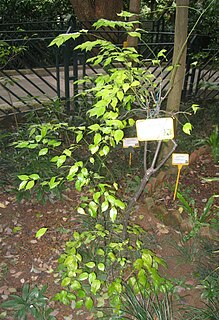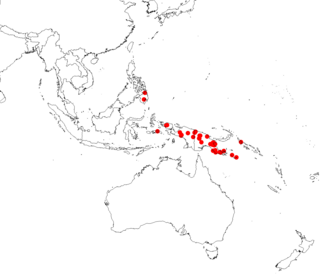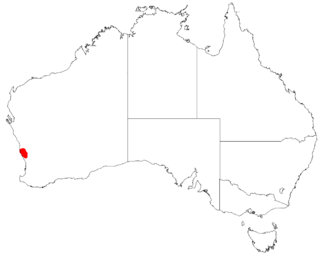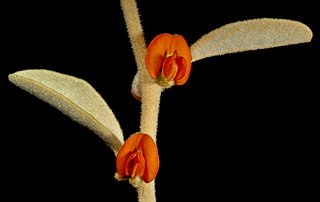
Pachypodium brevicaule is a species of plant that belongs to the family Apocynaceae.
Echinodorus horizontalis is a species of plants in the Alismataceae. It is native to northern South America.

Echinodorus macrophyllus is a species of aquatic plants in the Alismataceae. It is native to Brazil and Bolivia.
Cotoneaster tenuipes is an "extremely graceful," meter-high, hirsute, deciduous cotoneaster shrub endemic to the temperate regions of China. It was named and described by botanists Alfred Rehder and E.H.Wilson in 1912.

Tradescantia ozarkana, the Ozark spiderwort, is a species of Tradescantia. It is part of the Commelinaceae family, native to the States of Missouri, Arkansas, and Oklahoma in the south-central United States. It flowers from April to May and can be found in rich, rocky areas, including woods and bluff ledges.

Solanum evolvuloides is a species of Solanum, which was first described in 2011 by Giacomin & Stehmann. Solanum evolvuloides belongs to section Gonatotrichum, a small group assigned to the Brevantherum clade of the genus Solanum. It resembles Solanum turneroides Chodat, sharing with it heterandry, and Solanum parcistrigosum Bitter, with which it shares a similar habit and pubescence. Despite these similarities, the species can be recognized by its ovate-elliptic to cordiform leaf shape and more membranaceous leaf texture than the other species in the section, and stem, inflorescence axes, and calyx vestiture mainly composed of glandular hairs. Solanum evolvuloides is known to occur only in southeastern of Bahia state, Brazil, and in a preliminary assessment of the International Union for Conservation of Nature (IUCN) criteria can be considered a threatened species.
Borthwickia is genus of flowering plants, containing one species, Borthwickia trifoliata from Yunnan, China and Myanmar. The common name in Chinese is 节蒴木. It is a shrub or small tree with evergreen trifoliate leaves, whitish flowers clustered at the tip of the branches, with many stamens, and thin, knobbly, drooping fruits with many small red seeds.
Adenorandia is a monotypic genus of flowering plants in the family Rubiaceae. It was described by Vermoesen in 1922. The genus contains only one species, viz. Adenorandia kalbreyeri, which is found from west-central tropical Africa.

Ipomoea oenotherae is a species of plant of the morning glory genus, Ipomoea, in the family Convolvulaceae. It derives its name from the resemblance it bears to plants in the genus Oenothera. Ipomoea oenotherae is a succulent and a cryptophyte.

Cadaba aphylla ("Swartstorm") is one of some 30 species in the genus Cadaba. It is indigenous to southern Africa.

Ilex asprella, also known as rough-leaved holly and plum-leaved holly, is a deciduous shrub native in South East Asia. Ilex asprella is one of the few deciduous species in the family Aquifoliaceae.

Quoya verbascina, commonly known as golden bush, is a flowering plant in the mint family Lamiaceae and is endemic to Western Australia. It is an erect shrub with its branches and leaves densely covered with woolly hairs. The leaves are often oblong but very variable in shape and the flowers are pinkish-white with pink spots inside and are surrounded by yellow woolly sepals.
Hypericum cuisinii is a perennial herb in the genus Hypericum, in the section Adenosepalum. The herb has pale yellow flowers and occurs in Greece and Turkey.

Parsonsia curvisepala is a woody vine of the family Apocynaceae, found in Malaysia, New Guinea, the Philippines, the Solomon Islands, and Sulawesi. This species is second only to Parsonsia alboflavescens in its variability and wide geographic distribution.

Felicia nordenstamii is a flowering shrub in the daisy family, Asteraceae. It is found only in South Africa where it grows on limestone hills close to the sea on the southern coast. Felicia nordenstamii is a many-branched shrub growing up to 30 cm (1 ft) tall. The lower parts of the stems are covered in grayish brown bark and the upper stem has many crowded, upwardly angled, alternate leaves with long hairs on the lower surfaces. Large flower heads form at the tips of the branches, each about 41⁄2 cm across, with about thirty purplish blue ray florets surrounding many yellow disc florets.
Goniothalamus velutinus is a species of plant in the family Annonaceae. It is native to Borneo. Herbert Airy Shaw, the English botanist who first formally described the species, named it after the dense velvety hair on its branchlets and petioles.

Conostylis angustifolia is a rhizomatous, tufted perennial plant species in the family Haemodoraceae, endemic to the south-west of Western Australia. In September and October it produces yellow flowers in the species' native range.
Asteranthe lutea is a species of plant in the genus Asteranthe. It is native to Tanzania. Kaj Borge Vollesen, the botanist who first formally described the species in 1980, named it after its yellow petals.

Tephrosia arenicola is a plant in the Fabaceae family, native to the north of Western Australia. The species has no synonyms.
Struthiola tetralepis is a willowy shrublet of up to 30 cm (0.98 ft) high that is assigned to the family Thymelaeaceae. It has long straight branches that are initially hairy and are covered in leaves pressed against them. These leaves are small, overlapping, lance-shaped, scharply pointed, have a regular row of hairs along the margins, and 3-5 veins are visible on the outward facing surface. It has initially greenish yellow, later reddish brown flowers, each of which consists of a tube of about 1 cm (0.39 in) long with 4 lance-shaped, pointed sepal lobes and 4 yellow alternating petal-like scales. It flowers between October and February. It can be found in the southwest of the Western Cape province of South Africa. It is sometimes called cross capespray in English.











